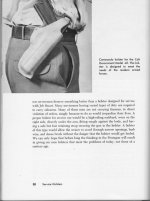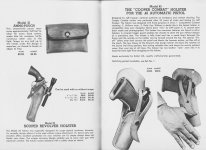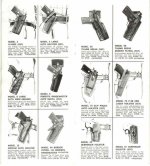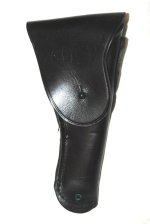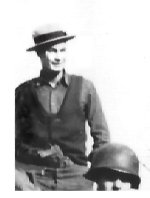rednichols
Member
. . . about what we call 'cocked and locked' carry of the 1911 and which Jeff Cooper labelled Condition One. In another post (A New Paradigm) it came up that not everyone is familiar with the history of this pistol has been carried, historically, and the timeline.
Rather than blur that thread, I've started a new one (p.s., everyone who has posted over there has been very nice ).
).
The history of holsters (I've labelled it 'holstory') is as old as revolving pistols. That's because until then, with only a single shot they were left with the horse; once fired they became clubs. The cartridge pistol increased the need that holsters filled -- and very shortly after made the auto pistol possible.
The holstory of auto pistol holster therefore evolved differently: they began to find acceptance with WW1 and we got our 1911 as a result. To carry it: what is known as the M1916 holster. The 1911 was approved to be carried in the holster in Condition Three, not least because even today a pistol is not issued to everyone, and it is a PDW (personal defence weapon) not a primary assault piece.
So: 1908 brought us the Luger, 1911 brought us the Government Model, 1938 brought us the P38, 1950-ish brought us the M39. This matters because in 1970, when I joined the Bianchi Holster company, these were the only locked blowback pistols to make holsters for (admitting that on very rare occasions we would make one for the old Mausers). No SIGS, no Glocks, not even M59s.
The best known, and one of the few, to authorise the carry of the 1911 was the Texas Rangers, because of the ability of the Super .38 to penetrate car bodies. The 38/44 loading for revolvers was introduced for the same reason, quickly supplanted by the 357 Magnum.
Really, then, holster makers until 1970 derived the bulk of their sales from revolver holsters. And the 1911 was not carried in Condition One. Here's a bit of a pictorial timeline:
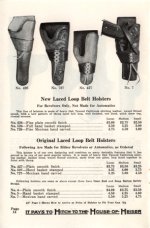 1943 Heiser
1943 Heiser
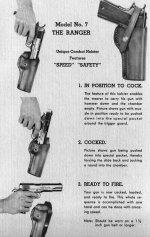 1964 Bianchi
1964 Bianchi
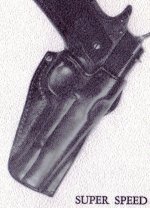 1969 Seventrees
1969 Seventrees
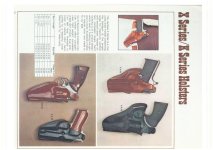 1979 Galco
1979 Galco
All are Condition Three, as are every other auto holster (aren't many) in these catalogues.
Of special note, as an affirmation of the paradigm that autos were carried in Condition Three, is the Bianchi (second image): draw in Condition Three and rack the slide to load a round.
The first Condition One image that I have, appears in a Bianchi catalogue of 1971; it is unfortunately a .tiff format and won't upload to the forum, and the computer I use to convert .tiff to .jpeg is down.
I've a copy of an old Cooper article from the '60s, in which he's arguing towards police departments taking Condition One seriously. it just wasn't done then. Easy to find an exception or two. But that's all.
Condition One in holsters was directly derived from what was once called "combat shooting", which the PC lot renamed "action shooting". And that began with Cooper and Big Bear, which was the transition from the fast-draw SAA craze of the 1950s using blanks, to live ammo with 1911s. Same holster makers, too: Anderson and Alfonso. And it was the Bianchi Cup of 1979 that validated this style.
But remember: despite a tournament's competitors using 1911s in major calibers, they are NOT permitted to be loaded at all, until the competitor is on the firing line and the range master has given the command to load; and then unloaded. It is NOT the same as carrying IWB at Walmart. And competition generally begins from the standing position.
Yet something bad happened: the carrying of pistols the way they are carried (empty) on pistol ranges 'bled' over to the street. And to being seated while carrying that way. And to dispensing with a safety strap. All of which has a reasonable chance of succeeding with proper training.
But not, which was the point of my "new paradigm" post, with striker fired pistols. The strap was not just for retention on 1911s and on DA revolvers: they blocked hammer movement, which prevented cycling to fire. WE HOLSTER MAKERS CANNOT PREVENT A STRIKER FIRED PISTOL FROM FIRING WHEN THE TRIGGER IS PULLED.
It is not the same problem, but it is being TREATED as the same problem, as carrying a 1911 in Condition One. Instead it is like carrying a DA or SA revolver already cocked.
Rather than blur that thread, I've started a new one (p.s., everyone who has posted over there has been very nice
The history of holsters (I've labelled it 'holstory') is as old as revolving pistols. That's because until then, with only a single shot they were left with the horse; once fired they became clubs. The cartridge pistol increased the need that holsters filled -- and very shortly after made the auto pistol possible.
The holstory of auto pistol holster therefore evolved differently: they began to find acceptance with WW1 and we got our 1911 as a result. To carry it: what is known as the M1916 holster. The 1911 was approved to be carried in the holster in Condition Three, not least because even today a pistol is not issued to everyone, and it is a PDW (personal defence weapon) not a primary assault piece.
So: 1908 brought us the Luger, 1911 brought us the Government Model, 1938 brought us the P38, 1950-ish brought us the M39. This matters because in 1970, when I joined the Bianchi Holster company, these were the only locked blowback pistols to make holsters for (admitting that on very rare occasions we would make one for the old Mausers). No SIGS, no Glocks, not even M59s.
The best known, and one of the few, to authorise the carry of the 1911 was the Texas Rangers, because of the ability of the Super .38 to penetrate car bodies. The 38/44 loading for revolvers was introduced for the same reason, quickly supplanted by the 357 Magnum.
Really, then, holster makers until 1970 derived the bulk of their sales from revolver holsters. And the 1911 was not carried in Condition One. Here's a bit of a pictorial timeline:
 1943 Heiser
1943 Heiser 1964 Bianchi
1964 Bianchi 1969 Seventrees
1969 Seventrees 1979 Galco
1979 GalcoAll are Condition Three, as are every other auto holster (aren't many) in these catalogues.
Of special note, as an affirmation of the paradigm that autos were carried in Condition Three, is the Bianchi (second image): draw in Condition Three and rack the slide to load a round.
The first Condition One image that I have, appears in a Bianchi catalogue of 1971; it is unfortunately a .tiff format and won't upload to the forum, and the computer I use to convert .tiff to .jpeg is down.
I've a copy of an old Cooper article from the '60s, in which he's arguing towards police departments taking Condition One seriously. it just wasn't done then. Easy to find an exception or two. But that's all.
Condition One in holsters was directly derived from what was once called "combat shooting", which the PC lot renamed "action shooting". And that began with Cooper and Big Bear, which was the transition from the fast-draw SAA craze of the 1950s using blanks, to live ammo with 1911s. Same holster makers, too: Anderson and Alfonso. And it was the Bianchi Cup of 1979 that validated this style.
But remember: despite a tournament's competitors using 1911s in major calibers, they are NOT permitted to be loaded at all, until the competitor is on the firing line and the range master has given the command to load; and then unloaded. It is NOT the same as carrying IWB at Walmart. And competition generally begins from the standing position.
Yet something bad happened: the carrying of pistols the way they are carried (empty) on pistol ranges 'bled' over to the street. And to being seated while carrying that way. And to dispensing with a safety strap. All of which has a reasonable chance of succeeding with proper training.
But not, which was the point of my "new paradigm" post, with striker fired pistols. The strap was not just for retention on 1911s and on DA revolvers: they blocked hammer movement, which prevented cycling to fire. WE HOLSTER MAKERS CANNOT PREVENT A STRIKER FIRED PISTOL FROM FIRING WHEN THE TRIGGER IS PULLED.
It is not the same problem, but it is being TREATED as the same problem, as carrying a 1911 in Condition One. Instead it is like carrying a DA or SA revolver already cocked.


